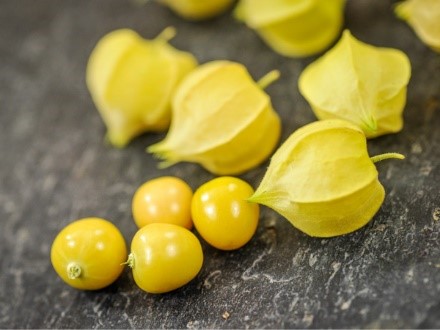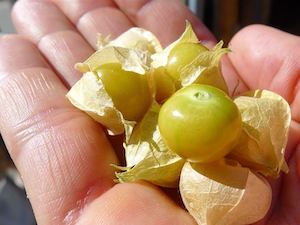International Gardener
Growing Your Own Groundcherries
By Julie M. Carpenter, Fairfax Master Gardener Intern
 With a hat tip to Johnny Appleseed, I come to sing the praises of another small, round, tart and sweet fruit. I speak of the humble groundcherry. So humble, in fact, no one really knows what to call it: golden berry, strawberry tomato, pineapple tomato, husk tomato, wintercherry, poha and even — sadly — clammy groundcherry. They are part of 80 to 100 members of the genus Physalis in the nightshade or Solanaceae family. The tomatillo and the ornamental Chinese lantern are close relatives.
With a hat tip to Johnny Appleseed, I come to sing the praises of another small, round, tart and sweet fruit. I speak of the humble groundcherry. So humble, in fact, no one really knows what to call it: golden berry, strawberry tomato, pineapple tomato, husk tomato, wintercherry, poha and even — sadly — clammy groundcherry. They are part of 80 to 100 members of the genus Physalis in the nightshade or Solanaceae family. The tomatillo and the ornamental Chinese lantern are close relatives.
The groundcherry is native to Central and South America, and it shows up from Poland to South Africa. However, botanist William Darlington noted an orange groundcherry in Pennsylvania in 1832, so it may be more “native” here than many of us are. And while earlier Americans who grew their own food knew it well, it did not adapt to the ship-to-the-grocery-store culture and thus has been somewhat forgotten.
But we can change that! Groundcherries are easy to grow. Like their nightshade cousins, tomatoes, these annuals like average soil, full sun and good drainage. They are best started from seed indoors six to eight weeks before your last frost. Like tomatoes, they need to harden off a little outside before planting. Planting them deep (up to the top two sets of leaves) ensures a vigorous root system. Give them plenty of space — each one will sprawl 3 to 4 feet wide, but only about 2 feet tall, so there’s little need to stake or cage. They are prolific, and you will get hundreds of groundcherries per plant, so regular fertilizer feedings are recommended. Seeds are available online through many sources; two heirloom varieties are ‘Aunt Molly’s’ and ‘Loewen Family Heirloom.’
And here’s the beauty: they self-seed. I started with two small seedlings three years ago, and now, I have dozens (ok, scores) of heirloom volunteers each year, which I thin down to three or four well-spaced plants. From those plants, I froze 20 quarts of groundcherries last year. You can make pies, jam, salsa, fruit ketchup, dry them into tiny raisins or just eat them straight. They also freeze beautifully, for delicious pies in the middle of winter.
 Like tomatillos, groundcherries grow in small papery husks. The husks ripen from green to tan, and when ripe, they simply fall off the plant onto the ground. Hence the name groundcherry. On the heirloom variety I grow – ‘Aunt Molly’s’ — the fruits ripen into small, golden, sweet and tart orbs that taste of apricot and pineapple. As with any nightshade plant, the leaves, stems and roots are toxic, and the fruit should be fully ripe before being eaten. In the husk, the fruit will keep up to a month indoors. Indeed, 18th century gardeners simply pulled the plant from the ground just before frost and hung it upside down, where the fruit would stay in the husks to be picked as needed during the winter. Hence their name wintercherry.
Like tomatillos, groundcherries grow in small papery husks. The husks ripen from green to tan, and when ripe, they simply fall off the plant onto the ground. Hence the name groundcherry. On the heirloom variety I grow – ‘Aunt Molly’s’ — the fruits ripen into small, golden, sweet and tart orbs that taste of apricot and pineapple. As with any nightshade plant, the leaves, stems and roots are toxic, and the fruit should be fully ripe before being eaten. In the husk, the fruit will keep up to a month indoors. Indeed, 18th century gardeners simply pulled the plant from the ground just before frost and hung it upside down, where the fruit would stay in the husks to be picked as needed during the winter. Hence their name wintercherry.
In my experience, groundcherries are bothered by few pests, but reports of flea beetles do show up in the literature. Neither the deer, the squirrels, nor the racoons that visit my yard have paid the least bit of attention.
Nowadays, you can find them at some farmers markets. I have even seen them at Wegmans in small, expensive packages called “goldenberries” if you grow your own, you can save that money, astonish your family, entice small children into your yard to see what those funny-looking husks are, connect with your South American culinary roots and eat pie all through the winter. Show me an apple that can do all that, Mr. Appleseed!
References
Aunt Molly’s Ground Cherry Info, Nikki Tilley, Gardening Know How
Physalis pruinosa a.k.a. “Ground Cherry”, Root Simple,
The Genus Physalis in Kentucky, The John W. Thieret Herbarium, Northern Kentucky University,
Tomatillo, husk-tomato, Neglected Crops: 1492 from a Different Perspective, Purdue University
Midwest Home Fruit Production Guide, Ohio State University Extension, Bulletin 940
Heirloom Nightshade Varieties, William Woys Weaver, Mother Earth News